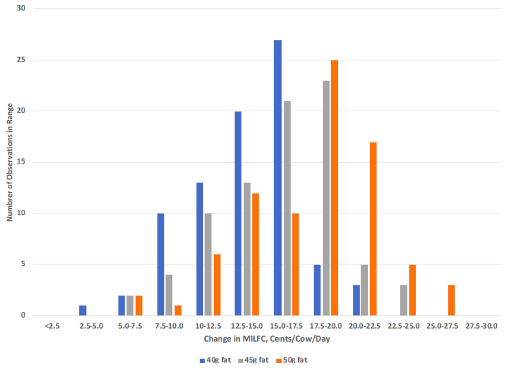Research Note
High-Oleic Soybeans:
Cost-Effective, Balanced Approach
 High oleic soybeans in lactation rations increase milk fat roughly 5% on average (up to about 65 g/d) versus conventional soybeans. They also lower the risk of milk fat depression — but not to zero risk — and appear to provide knock-on physiological benefits.
High oleic soybeans in lactation rations increase milk fat roughly 5% on average (up to about 65 g/d) versus conventional soybeans. They also lower the risk of milk fat depression — but not to zero risk — and appear to provide knock-on physiological benefits.
So, as the cost of supplemental fat continues to rise, HO beans represent a potentially cost-effective fat-protein opportunity, especially for dairies with corn-soy crop base or near crushers with HO segregation capability. However, HO beans are not a “fat panacea.”
Penn State’s Dr. Kevin Harvatine recommends a balanced approach to HO soybeans.
Previously in FeedInsight 4U, Harvatine advised ongoing consideration of all dietary fat sources, “which includes first feeding relatively inexpensive sources of rumen available fat, then selecting fat supplements based on your goal and specific situation….” He pointed to the “mid-range” of dietary fat sources that are rumen available and relatively economical — for example, oilseeds like HO soybeans and cottonseed.
What is the upside for HO soybeans in terms of income over feed cost (IFOC)?

Focusing on HO beans, Harvatine recommends:
- Generally, 5-10% of the diet works well because HO beans are both a fat and protein source while higher feeding rates push up rumen undegradable protein (RUP) and may displace cheaper protein sources.
- HO beans allow feeding more “rumen available” fat because the oleic acid has less impact on the rumen and less risk for milk fat depression — HO beans at 5% of the diet (2.75 lb/d) will decrease diet C18:2 fatty acid (FA) by about 1 percentage point.
- Lower risk of milk fat depression means you can feed more than conventional soybeans or feed along with other 18:2 sources like cottonseed.
- HO expeller meal is also available in some markets, and, although it has lower fat, it has the same benefit of less 18:2.
- Combining with other fat sources still makes sense — Michigan State researchers still saw benefits of combining with cottonseed and PA (palmitic acid) supplements.
- Don’t forget the fundamentals — use least cost formulation to meet both FA and protein-amino acid balancing goals.
“For HO beans,” Harvatine says, “roasting and cracking — not grinding — may be one of the best processing solutions.” He notes that while installing and managing new on-farm processing represents a significant long-term investment, nearby mobile soybean roasting services may be able demonstrate advantages short-term.
Next month, the Penn State 2024 Dairy Nutrition Workshop (Nov. 6-7, Hershey, PA) includes an Elanco-sponsored breakfast session on carbon credits and farm sustainability and a trade show of around 40 suppliers to the dairy industry.
Questions?
Email FeedInsight 4U

